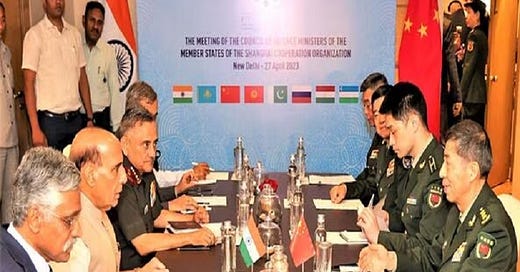China wants to freeze this problem and decouple it from the rest of its bilateral relations with India, while India insists that the status quo ante Galwan be restored as the condition for comprehensively expanding their ties in the new era. The first scenario risks framing India as China’s “junior partner” if Delhi tacitly accepts the changes along the Line of Actual Control while the second reverses the perception of their roles if Beijing goes back to the pre-Galwan state of military affairs.
The Chinese and Indian Defense Ministers, who are meeting in Delhi together with all their counterparts besides Pakistan’s as part of an SCO Summit, expressed polar opposite views of their border dispute. General Li Shangfu said that they “share far more common interests than differences” and “should view bilateral relations and each other's development from a comprehensive, long-term and strategic perspective, and jointly contribute wisdom and strength to the world and regional peace and stability.”
Rajnath Singh, meanwhile, released a statement informing everyone that he “categorically conveyed that development of relations between India and China is premised on prevalence of peace and tranquility at the borders. He reiterated that violation of existing agreements has eroded the entire basis of bilateral relations and disengagement at the border will logically be followed with de-escalation.” The present piece will now further elaborate on their diametrically opposed views towards this sensitive issue.
“The Strategic Dynamics Shaping The Latest Sino-Indo Tensions Are More Dangerous Than Usual”, which intrepid readers can learn more about in the preceding hyperlink that’s being referenced at this point to set the backdrop against which the latest Sino-Indo Defense Minister talks took place. Notably, this was the first visit by any such Chinese minister since those two’s deadly clashes in summer 2020 over the Galwan River Valley, which brought those neighboring Asian Great Powers to the brink of war back then.
Over the past month, they’ve sparred over the Northeast Indian state of Arunachal Pradesh, which China claims as South Tibet despite having only briefly controlled it during their 1962 war. The larger context in which their feud recently escalated concerns the impending trifurcation of International Relations into the US-led West’s Golden Billion, the Sino-Russo Entente, and the informally Indian-led Global South. The global systemic transition in mainland Asia will thus remain unstable pending this issue’s resolution.
“The US Is Trying To Mislead The World Into Thinking That India Is Its Ally Against China” in parallel with falsely framing Russia as China’s “junior partner”, both information warfare narratives of which are intended to divide-and-rule the Russia-India-China (RIC) core of BRICS and the SCO. American perception managers hope to manipulate Chinese policymakers into considering India part of the US’ emerging pan-Asian “containment” coalition while getting Indian ones to regard Russia as an unreliable partner.
Neither targeted audience has fallen for this trap even though some in their society have, including among their expert communities, not to mention observers from third states. The Sino-Indo border dispute therefore remains a purely bilateral issue despite the US’ attempts to multilateralize it in the minds of those two’s policymakers. This insight brings everything back to the latest meeting between their Defense Ministers in Delhi and their completely different views towards the border issue.
China wants to freeze this problem and decouple it from the rest of its bilateral relations with India, while India insists that the status quo ante Galwan be restored as the condition for comprehensively expanding their ties in the new era. The first scenario risks framing India as China’s “junior partner” if Delhi tacitly accepts the changes along the Line of Actual Control (LAC) while the second reverses the perception of their roles if Beijing goes back to the pre-Galwan state of military affairs.
Neither Prime Minister Modi nor President Xi is comfortable accepting an outcome that presents their country as subordinate to the other, but absent a hitherto unthought-of creative solution to this dispute, the two abovementioned ones are zero-sum in this respect. Their impasse accordingly remains in place, thus hamstringing any chance that they’ll cooperate more closely in accelerating their shared goal of financial multipolarity, including through BRICS when it comes to this group’s planned reserve currency.
This observation doesn’t mean that the aforesaid project won’t ultimately come to fruition, but just that it’s unlikely to reach its maximum potential due to these two’s suspicions of the other stemming from their unresolved border dispute. In response, each is expected to focus much more on internationalizing their own currency instead of relying on the BRICS one, with China prioritizing the petroyuan concept while India tries popularizing the rupee along its mainland and maritime trade routes.
As regards the SCO, they’ll continue participating in relevant events and specific subgroupings like the Afghan one that Russia just invited India to join, but the most that these Asian Great Powers will do is broadly coordinate instead of closely cooperate so long as their border dispute remains an issue. While some observers might be tempted to rush to judgement in praising one and condemning the other, the most optimal approach is simply to recognize that they’re trying to manage their intractable differences.
After all, everything could easily spiral out of control if either of them wanted that to happen, but they’ve thus far successfully prevented another Galwan incident from transpiring. China and India therefore deserve to be commended for this regardless of however one might feel about their respective positions towards this issue. Bilateral relations will likely remain tense for the foreseeable future and multilateral cooperation will suffer, but each seems fully prepared for this “new normal”.




